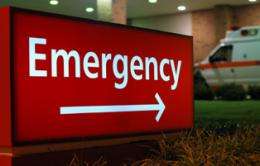(PhysOrg.com) -- In a new study, Yale University researchers document a disturbing lack of consistency among U.S. hospitals in how quickly they treat patients in emergency rooms. Furthermore, some hospitals were least able to provide timely care to the sickest patients. The study appears online early in Annals of Emergency Medicine.
Emergency department (ED) crowding has become so severe that the Institute of Medicine calls it a “national epidemic.” The Yale team studied nearly 36,000 visits to 364 emergency departments in the United States, analyzing data on how long it took for patients to be treated and the length of their stay before being either admitted or discharged. They found that in a typical ED, one-third of acutely ill patients waited longer than recommended at triage to be treated by a doctor, and one-quarter of patients who need to be admitted wait more than six hours for an inpatient bed.
The Yale team found wide variability in these times among the hospitals studied. Patients visiting the slowest EDs wait more than twice as long to be treated as those visiting the fastest EDs, and spend more than two extra hours waiting for an inpatient bed. This variability persists despite accounting for different patient demographic mixes at the hospitals.
Some factors contributing to these differences are outside a hospital’s control, such as the volume of patients. But lead author Leora Horwitz, M.D., Assistant Professor of Internal Medicine at Yale School of Medicine, says some things can be changed. “Hospitals can improve triage, registration, work assignments, lab testing and staffing procedures,” she says.
Perhaps most important, Horwitz says, is what’s called “output” - the availability of inpatient beds into which a hospital moves admitted patients.
“The fact that the differences we found among hospitals are so dramatic suggests that intrinsic hospital practices and procedures have a significant impact on patients’ experiences,” she explains, adding, “We urgently need to identify the practices that can best facilitate prompt attention, treatment and admission, and ensure that they are broadly applied across all emergency departments.”
Provided by Yale University (news : web)


















